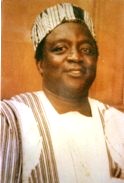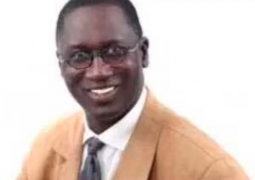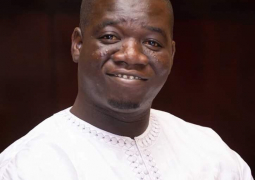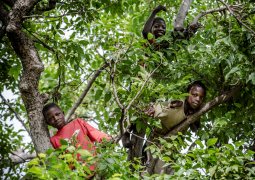
(These notes were gathered in 2003 and are still under review. Both Nana Grey-Johnson and Dr Tijan Sallah have since published more books, and these will feature in our reviews subsequently)
Gabriel J. Roberts (1929- )
Gabriel J. Roberts was born in 1926 in Bathurst (Banjul). He studied in Great Britain, where he obtained a Masters’ Degree and a Post-graduate Diploma in Education. A renowned educationist, Roberts rose to the position of Director of Education. From 1995 to 1997 and from 2000 to 2005, he was the first Chairman of the Independent Electoral Commission (IEC).
Gambian drama was introduced to an Anglophone audience thanks to Gabriel J. Roberts. The BBC awarded him a Literary Prize. Mr Roberts is also a poet and a novelist.
The Trial of Busumbala is a piece of drama written in 1971. We were in 1962, Maxwell Armitage, principal of Armitage School and a Member of the House of Representatives, is suing Marafan Busumbala for the theft of his radio set. The investigation will soon show that the plaintiff’s hands are far from clean. This piece of drama is a satyr that also shows campus life. This is precisely what the play is all about: a principal either abusing his privilege as principal and turns on his radio very loud with no care for the welfare of the neighbouring teachers or blindly selfish. Marafan Busumbala’s theft is justified as the court will rule out that it was done in the general public’s interest.
The Goosieganderan Myth, written in 1988, is a novel of 163 pages. The novel takes up the theme of his play A Coup is Planned, written in 1971 and always rewritten as a play entitled The Senegambian Myth. The union between The Gambia and Senegal is transposed to two imaginary countries known as Goosie, depicting the Gambia, under the leadership of Lady Sabrina, and Gandera depicting Senegal headed by Dynamic. The two are united by the deep love they have for each other at a personal level. Politically, however, their relationship will be complicated, especially with the army trying to convince Dynamic that Goosie is a small country that does not deserve to be an independent state but a part of Gandera. The army will take advantage of the amorous relationship between the two Heads of State to discreetly invade Goosie. According to Major General Kaba, a close ally and trusted friend of Lady Sabrina, the Ganderan army has claimed that the politicians have failed to take into account the military heads of the two countries.
Ebou Dibba (1943-2000)
The late Ebou Dibba, who passed away in England, played a significant role in depicting Gambian life in his books. He is equally the first Gambian author to make a continuation of his first story into a second book. The late Ebou Dibba’s first novel, Chaff on the Wind, is set in The Gambia. Some of the characters of Chaff on the Wind are found in his second novel Fafa creating thus an apparent link between the two. His novel Alhaji marks the inauguration of a literary genre targeting above all the youths. However, it should not be forgotten that Ebou eequally wrote Olu and the Smugglers, but nowhere could any of those involved in this research find this book. It would have been a pleasure to read it and include it in this analysis.
Chaff on the Wind is a novel of 203 pages, written in 1986 and published by Macmillan Education. The novel is about two young men, Dingding and Pateh, who came from the countryside on board of a ship in their thirties. The latter is ambitious and enterprising. He quickly finds himself a job and seduces a young girl called Isatou. Dingding is the opposite of Pateh. He is shy and reserved. But he is luckier than Pateh. Isatou is married to Charles, the old cousin of a Signare. She hates this relationship. She ends up carrying the baby of …Pateh. Both of them have to flee to Senegal. Dingding becomes a successful businessman. Pateh is of his employees. Pateh finally dies following his numerous encounters with the French colonial police.
Fafa is a novel of 118 pages published in 1989 by Macmillan Education. Four friends are the main characters of this novel set in the fifties: Sisi Massod, the shopkeeper from Morocco, “Guerre Quatorze” who fought the first World War, “Professor” a teacher and Fafa, the watchman. Fafa wants to marry Kombeh (who is also found in Chaff on the Wind) who is not ready to engage herself in any relationship with him. He is not the type of man she is looking for. The three friends will crack their brains to map out strategies to resolve the problems.
Alhaji, novel meant for young readers has 72 pages. It was published in 1992 by Macmillan. Alhaji, 16, receives a horse as a present from a tourist. He names the horse after himself. One day, he is taken on a ride on his way to school. Kebba, the driver and proprietor of the vehicle, invites Alhaji to his hotel where, to seduce him into selling his horse, he is offered a prostitute. He realises that Kebba has an eye on his horse. He is adamant even to borrow his horse, not mentioning selling it to Kebba, Alhaji, the horse, is stolen. Kebba will use the horse to smuggle diamonds into Senegal and eventually to Scandinavia. Fortunately, indirectly assisting the Sierra Leonian Police, Alhaji the horse is found by Alhaji the hero. Quasi, the maths teacher com detective and Johnson the Policeman from Sierra Leone, will provide the helicopter by which they will travel to pursue the criminal Kebba, who will be intercepted after Kaolack and around Fattick Senegal. The smugglers find themselves behind bars.
Nana Grey-Johnson (1951- )
Nana Grey-Johnson was born in 1951 in Banjul. He obtained his B.A. in Communication and his M.A. in Journalism in 1979 from the University of Stanford in the USA. He contributed to many newspapers and reviews before establishing his own Agency of Media and Communication and having a publication of his own. He is a member of many associations, one of which is the Gambian branch of Defence and Protection of Children (Geneva, Suisse). He also published the History of the Newspaper in The Gambia.
A Krio Engagement and other stories is the first Gambian collection of short stories published in 1987 in Banjul by BPMRU, under the pen name Nana Humasi. It is a book of 103 pages with illustrations for each story. This collection comprises nine short stories, of which seven have already been published in the magazine West Africa. The stories deal with different subjects, most of which depict some of our Gambian social beliefs and culture. The vitality and the daily excitement of the daily life of Bathust (Banjul) residents in their everyday lives can be discovered in many of the stories. The first story, The Man Who Came To His Own Requiem, was set in December 1946. The freighter and passenger steamer, HMCS Lady Denham (named after the wife of Governor of the Gambia from 1928 to 1930, Sir E. Denham), will sink after colliding with another steamer, HMCS Vic 20 three miles above Nianimaru. There were no deaths but one of the passengers, Pa Alaba Roberts, was thought drowned when he was not found after three days, and therefore his family offered the customary three-day charity. At this moment, Pa Alaba, who was not dead, arrived in Bathurst when the people were at the requiem. The reaction of those who saw him was of fear and dread instead of joy because as they were convinced Pa Alaba was dead, what they believed they were seeing was his ghost. How will he arrive at being accepted by these people, especially his family, who share the same sentiments with others? The last story, Week-end in July recalls the attempted coup d’état of July 1981 and the fear, destruction, senseless deaths and the economic disaster.
Nana Grey-Johnson equally wrote other plays and another collection of short stories. King Pass King, is a play in Krio published in 1988. The Hare and the Tortoise, is a musical drama accompanied by choreography. It has two versions: Wolof and English. Children of the Spyglass, a collection of three short stories (75pages), was published in Banjul in 1995. The first story, The Snake Man, was produced by BBC in 1988; the third one, Children of the Spyglass won a prize in the USA in 1994. The second story of the collection, Kumelo, ship’s Chandler written in 1993, was inspired by a story narrated by A. Auber.
The Magic Calabash, a novel of 161 pages, was published in 1998 in Banjul. This novel narrates the misfortunes of Erubani, an office boy at the Land Registry, who is sacked because of the pressure of the World Bank on the government of the country. Unemployed, living with a young woman he has not yet married, accused of theft by his aunt, Erubani is just accumulating problems. Nevertheless, one realises that he can find money with the help of an object…..a magic object. But he will face one disaster after the other like in a nightmare.
I of Ebony is a novel of 292 pages, and it was published in 1999 in Banjul. In 1834, Simanga was captured in his village to be taken as a slave with other men and women from different regions along the river Gambia. This situation was one of forced cohabitation of populations who were satisfied to coexist. A cruel slave-merchant reigned on the island where the “prisoners” were herded. But Simanga will be able to rebel against him and escape from the island. He was forced somehow to take refuge in Bathurst as, at that time, the British forbade slavery in their colonies and housed refugees because they did not have the means to prevent and forbid the slave trade. This book can be considered a response, from within, to the odyssey of slaves taken to the USA (Alex Haley’s book Roots portrays the story).
Tijan M. Sallah (1958- )
Tijan M. Sallah was born in 1958 in The Gambia. He studied in the U.S., where he obtained a Bachelor of Economics in 1982, an M.A 1984 and a PhD in Economics three years later. From 1981 to 1989, he delivered lectures in many American Universities. He joined the World Bank in 1989, and he is the Bank’s Senior Economist in charge of Egypt, Jordan and Yemen at the Water, Natural Resources and Environment Division. In addition to his numerous publications in reviews and his literary works, he has published a book entitled Wollof (New York,1996).
When Africa was A Young Woman, published by Calcutta in 1980, is a collection of 36 poems. The work is divided into two parts: The first, On Africa, comprises nine poems and the second, On People, Places and Things, has 27 poems. A spirited response of a young man aged 22.
Before the New Earth was published by Calcutta in 1988, a collection of 16 short stories (including a Letter from Wole Soyinka to the author) comprises 93 pages. The author raises his voice against the North-South inequalities and their consequences on Africa. He is dreaming of a New Earth with New Human Values.
Kora Land published in the USA in 1989, is a collection of 25 poems. “ I consider myself to be a griot flying over the Gambian land, but seeing it in its interrelation with other lands”. The poems deal with religion and the Ancestors.
Dreams of Dusty Roads was also published in the USA in 1993, four years after Kora Land, is a collection of 34 poems divided into three parts: Roots, Branches (America), Dream-Clouds (in the Mind). Beyond material things, Man craves for spiritual things, longing for the Dream Kingdom where he can experience something that transcends him and will bring about spiritual fulfilment.
New Poets of West Africa (1995) is an Anthology of 156 pages, where you can come across seven female poets out of 48 from 15 West African countries. They all belong to the third generation of African poets of the seventies and eighties.
New African Poetry (USA, 1999) has 350 pages and is another Anthology covering this time the whole continent. The euphoria of independence gradually gives way to an era of disenchantment. Sixty-six poets will figure in this anthology, and among them are 17 women.





